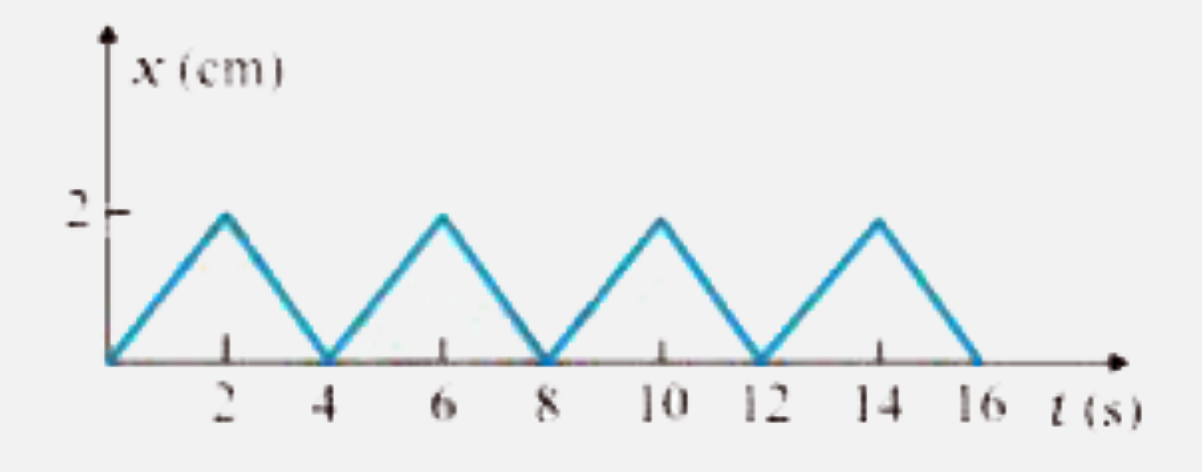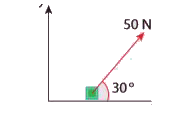A man of mass 70 kg stands on a weighing machine in a lift , which is moving (a) upwards with a unifrom speed of 10ms−1 (b) downwards with a unifrom acceleration of 5ms−2
(c) upwards with a unifrom acceleration of 5ms−2 What would be th readings on the scale in each case ?
(d) What would be the reading if the lift machanism failed and it hurtled down freely under gravity ?Solution in Tamil
The reading on the scale is a measure of the force on the floor by the man. By the Third Law, this is equal and opposite to the normal force N on the man by the floor.
(a) N=70×10=700N: Reading is 70 kg
(b) 70×10−N=70×5 : Reading is 35 kg
(c ) N−70×10=70×5 : Reading is 105 kg
(d) 70×10−N=70×10 : Reading would be zero, the scale would be read zero .
Topper's Solved these Questions
- BOOK - NCERT TAMILCHAPTER - LAW OF MOTIONEXERCISE - EXERCISE (ADDITIONAL EXERCISE)17videos
LAW OF MOTION
- BOOK - NCERT TAMILCHAPTER - LAW OF MOTIONEXERCISE - EXERCISE (ADDITIONAL EXERCISE)17videos
LAW OF MOTION
- BOOK - NCERT TAMILCHAPTER - KINETIC THEORY OF GASESEXERCISE - EVALUATION (Numerical Problems)8videos
KINETIC THEORY OF GASES
- BOOK - NCERT TAMILCHAPTER - LAWS OF MOTIONEXERCISE - EXERCISE (V. Numerical Problems)14videos
LAWS OF MOTION
Similar Questions
Figure shows the position-time graph of a body of mass 0.04 kg. Suggest a suitable physical context for this motion. What is the time between two consecutive impulses received by the body ? What is the magnitude of each impulse ?
 05:18View Solution
05:18View SolutionFigure shows the position-time graph of a body of mass 0.04 kg. Suggest a suitable physical context for this motion. What is the time between two consecutive impulses received by the body ? What is the magnitude of each impulse ?
 03:04View Solution
03:04View SolutionA fresh air is composed of nitrogen N2(78%) and oxygen O2(21%). Find the rms speed of N2 and O2 at 20∘C.
View SolutionA force of 50N act on the object of mass 20 kg. shown in the figure. Calculate the acceleration of the object in x and y directions
 14:45View Solution
14:45View SolutionA man of mass 70 kg stands on a weighing machine in a lift , which is moving (a) upwards with a unifrom speed of 10^(-1) (b) downwards with a unifrom acceleration of 5 ms^(-2) (c) upwards with a unifrom acceleration of ms^(-2) What would be th readings on the scale in each case ? (d) What would be the reading if the lift machanism failed and it hurtled down freely under gravity ?
03:49View SolutionA man of mass 70 kg stands on a weighing scale in a lift which is moving (a) upwards with a uniform speed of 10 m s^(-1) , (b) downwards with a uniform acceleration of 5 m s^(-2) , (c) upwards with a uniform acceleration of 5 m s^(-2) . What would be the readings on the scale in each case? (d) What would be the reading if the lift mechanism failed and it hurtled down freely under gravity ?
03:36View SolutionA man of mass 70 kg stands on a weighing scale in a lift which is moving (a) upwards with a uniform speed of 10ms−1 , (b) downwards with a uniform acceleration of 5ms−2, (c) upwards with a uniform acceleration of 5ms−2 . What would be the readings on the scale in each case? (d) What would be the reading if the lift mechanism failed and it hurtled down freely under gravity ?
04:23View SolutionA man of mass 70 kg stands on a weighing scale in a lift which is moving (a) upwards with a uniform speed of 10ms−1 , (b) downwards with a uniform acceleration of 5ms−2, (c) upwards with a uniform acceleration of 5ms−2 . What would be the readings on the scale in each case? (d) What would be the reading if the lift mechanism failed and it hurtled down freely under gravity ?
02:59View SolutionA man of mass 70 kg stands on a weighing machine in a lift, which is moving (a) upwards with a uniform speed of 10ms^(-1) (b) downwards with a uniform acceleration of 5 ms^(-2) (c) upwards with a uniform acceleration of 5 ms^(-2) What would be the readings on the scale in each case ? (d) What would be the reading if the lift mechanism failed and it hurtled down freely under gravity ?
05:40View SolutionA man of mass 70 kg stands on a weighing scale in a lift which is moving (a) upwards with a uniform speed of 10 m s 1, (b) downwards with a uniform acceleration of 5 ms^(2) , (c) upwards with a uniform acceleration of 5 ms^(2) . What would be the readings on the scale in each case ? (d) What would be the reading if the lift mechanism failed and it hurtled down freely under gravity ?
03:16View SolutionA person of mass 50 kg stands on a weighing scale on a lift. If the lift is descending with a downward acceleration of 9 ms−2, what would be the reading of the weighing scale ? (g = 10 ms−2)
02:21View SolutionA man of mass 70 kg stands on a weighing scale in a lift which is moving downward with the uniform acceleration of 5ms2 . The reading on the weighing scale is
02:27View SolutionA man of mass 70kg stands on a weighing scale in a lift which is moving upwards with a uniform acceleration of 10ms^(-2) . What would be the reading of the scale during their upward movement?
01:58View SolutionA man of mass 70kg stands on a weighing scale in a lift which is moving
upwards with a uniform acceleration of 5ms−2
What would be the reading on the scale?View SolutionA spring weighing machine inside a stationary lift reads 50kg when a man stands on it. What would happen to the scale reading if the lift is moving upward with constant acceleration?
09:34View SolutionA man of mass 70 kg stands on a weighing scale in a lift which is moving downward with the uniform acceleration of 5 m/s^2 . The reading on the weighing scale is
02:40View Solution

